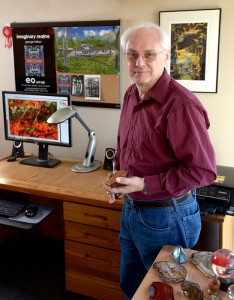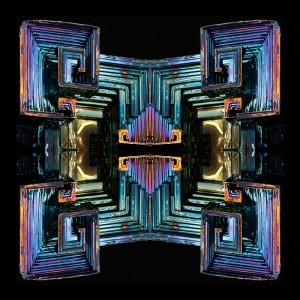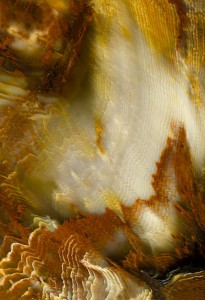Tea for Creatives: George Fellner Photographs Imaginary Realms
George Fellner, photographer and architect, is committed to a dual life-path involving visual discovery and design. His photographic subjects include landscape, architecture, travel, portrait, and objects of nature. The focus of his present work: Imaginary Realms reveals an endless search for the abstractions of reality. His process involves the macro-photography of stones and crystals, offering limitless material for evocative images.
George’s photographs have been presented in journals, books and travel guides. Nature Genetics, an international science journal, has featured three of his photographs for front covers. INK Publications magazine featured the article Photographer George Fellner: Architect for Body and Spirit with an in-depth description of his art and methodology for Imaginary Realms. In addition, George’s photographs of his architectural designs appear in a series of three books by E. Ashley Rooney. Her upcoming book: Artists’ Homes and Studios will feature George’s studio space design and abstract photography.
His fine art photographs have been widely exhibited in art galleries and museums as well as solo shows. George’s limited edition prints are now part of a number of permanent art collections. Most recently, the Yale School of Medicine acquired five of his images, which are now exhibited at the Brady Memorial Lab. The NYC headquarters for Nature Genetics exhibits three of his images.
What does creativity mean to you?
Creativity is all about allowing the imagination to fly. The spark of an idea can germinate and flow through a process, evolving and sometimes taking multiple directions. Ultimately, the resolution or conclusion is the final product that is a form of expression.
What unexpected directions has creativity taken your life/career?
Creativity has been an integral part of my being since I was a child. Creative expression began with pencil sketches, pen and ink, watercolors, and eventually oil paintings. As a college student studying design methodology, I realized wanted to pursue a career as an architect. Eventually, I got interested in photography. I explored all genres including landscape, architecture, travel, wildlife, portrait, and a few others. It was all quite a natural progression.
An unexpected direction occurred in 2004 when a friend of mine suggested that I might try to photograph the minerals that were sitting in my sunroom. Within a few weeks, I felt
drawn to partake in this task. At first, it was obvious that I needed to learn the pragmatic and technical aspects of using proper equipment and techniques for macro photography. Once perfected, I was able to focus on the pure creative aspects of photographing stones and crystals. The enthusiasm and evolving implementation for this form of abstract expression has become integral aspect in my ‘personal gestalt.’
Take us through your creative process, from the beginning to the end of a photo session.
It begins with a visit to a stone shop or to a gem and mineral show. Acting in the role of hunter/gatherer, I search the displays for potential source material. I look for unique pieces that reveal intriguing patterns, colors, and textures. I intuitively feel a connection as if I can sense an awareness of the secret language within. As I allow my mind to roam, there are often the beginnings of a particular theme, articulated image, story, or emotion.
Upon gathering a few pieces, I select a good day to do a photo shoot. I listen to ambient/electronic-type music, free myself from outside distractions, and allow myself to become immersed within a mode of clarity and multisensory awareness. The source subject is set up in my studio with camera equipment, lighting, and assorted accessories. I essentially embark upon a journey, exploring the secret language of stones and crystals. Scoping out the various regions, playing with scale variations, and defining borders are all part of my technique. As I gaze through the lens, I search for compositions formed by patterns, colors, textures, contrasts, and tonal gradations. Simultaneously, I open my senses and allow my mind to contemplate messages from history, mythology, geography, geology, biology, astronomy, physics, spirituality, culture, and other fields of interest. It is all fair game regarding themes offering multiple points of departure, and my mind is stimulated to visualize a myriad of possibilities.
The journey of discovery progresses as hidden memories and inner dreams occasionally filter through…Within the image possibilities, ancient and future fantasies, as well as planetary and cosmic-scapes, that traverse space, time, and dimension are often conceived. Indeed, this process often results in the contemplation of alternative realities and Imaginary Realms.
(Watch a video of George narrating this process and experience his many imaginary realms!)
Describe the biggest creative obstacle you’ve faced? How did you work through it?
The most significant creative obstacle that I have faced is to let go of conventional thinking. We all can become hindered by techniques and strategies that seem to work—we stay in our comfort zone. As I have explored many dozens of types of minerals in my photographic adventures, I have often found new types required new ways of thinking to photograph. Thus, I allow my mind to accept variations in my process, technique, lighting, as well as basic strategies for new concepts. This continues to allow for an evolving body of work for my Imaginary Realms series.
Who, or what inspires you?
I am inspired by many themes such as culture, mythology, astronomy, etc. as I described earlier. I have been greatly influenced by the art movements of Impressionism, Expressionism, Cubism, and Surrealism. The depictions of light, movement, atmosphere, and emotion, as well as distorted and abstracted visions within paintings from these periods have certainly influenced my work. In addition, the fragmentation of geometry and form with the intent of forming new constructs is something I occasionally do with my quad technique, which often results in surprising and whimsical juxtapositions.
If you could choose one quote or theme song as your mantra, what would it be?
“The central process of art is not to render something exactly as it appears, but to simplify it so that meaning, clarity, emotional response, and a sense of order combine to create a style from within.” This is a quote from the late photographer Galen Rowell.
What character from a book or film best represents your creative self?
Dr. Who. I enjoy the way he is always conjuring up creative solutions to problems that are not conventional.
You are hosting a tea party. You can invite two special guests, living or dead. Who do you invite? Why?
I would invite the artists Marcel Duchamp and Salvador Dali for a tea party. Their amazing and influential works respectively with conceptual art/cubism and surrealism would certainly evoke stimulating conversation!
Do you have a favorite ritual for preparing tea?
My favorite ritual for preparing tea is to go through my many boxes of tea varieties, make a careful selection based upon my present state of mind, and read the little descriptions about history and attributes. I often let the tea bag steep longer to allow for a bit stronger flavor. I drink it very slowly for a good length of time as I listen to music and read a good book.
Upcoming: “Out of the Box” Spectrum Gallery, 61 Main St., Centerbrook, CT.
Opening Reception August 22 at 6:30-9:00pm
Join the conversation on Facebook and see what George has recently captured through his magical lens.
Tags: abstract art, architect, art, artist, artist process, Connecticut, creative, creative minds, creative process, design, Fellner Architects, Fellner Visions, George Fellner, Imaginary Realms, inspiration, Nature Genetics, photographer, Possibiliteas, surrealism, tea for creatives, Yale
Trackback from your site.




Rena Tobey
| #
That would be a Great tea party. Congratulations on the article, George, and on your gorgeous work!
Reply
karenrider
| #
Thank you Rena, for visiting the blog. We’re glad you enjoyed this interview. Hope you’ll share a cup of tea with George to celebrate!
Reply
George Fellner
| #
Thanks Rena, that tea party seems to have inspired a good number of people…! And…, I appreciate you checking out my work….!
Reply
Ross Spiegel
| #
Thanks for featuring George Fellner in your blog posting. Your interview shows that creative genius has no bounds. Architecture is often referred to as frozen music and his photography shows that the concept can spill over into photography as well.
Reply
karenrider
| #
George has an interesting mind, no doubt! We love the vignettes he writes for each of his Imaginary Realms images… the interplay of language, light, color and shadow spark the imagination in all who see his work.
Reply
George Fellner
| #
Thanks Ross and Karen…..! Glad that my “Imaginary Realms” spark your imagination….!
Reply